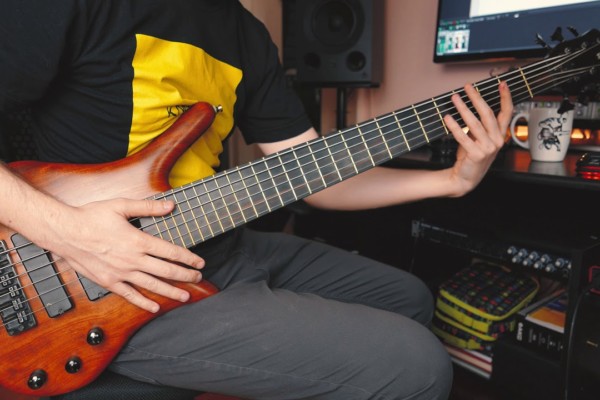Upright Slap Bass (Rockabilly/Psychobilly): Instrument Setup and Equipment
This is the final installment of Dr. D’s 3-part Slap Bass series. Check out part 1 and part 2.
In addition to having its own specialized musical and technical considerations, Playing Upright Slap has its own particular instrumental setup issues. Here are some basic things slap players need to think about when customizing their bass for their specific situation.
String Action: A greater distance between the string and the fingerboard (when compared to the action of classical and jazz players) is often suggested. The greater distance allows the fingers of the right hand to grab underneath the string more easily (i.e. between the string and the fingerboard). While higher action is certainly helpful, experience will show that the strings can actually be quite low provided the player stays loose. You need only enough space to get your finger under the string, no more. Some players get around this by playing below the fingerboard, where there is plenty of room to grab the string. Either way, get it the strings as low as you can and still play the technique.
Fingerboards: Traditionalists, Bluegrass and some Nashville players often prefer rosewood fingerboards for the “thump” they produce. Rockabilly and Psychobilly folks tend to like ebony. ?
Strings:
Gut: These are generally thicker than metal strings, often with less sustain and are great for acoustic groups and more traditional genres.
Nylon: A modern economical option to more problematic gut strings. These are similar in tone, quality and response to guts, but with more stability and a thinner gauge. Nearly impossible to bow….if you were thinking about it.
Weedwackers: Easy to play, economical and unique looking (bright green is a common color). These are cheap and easy on the hands, but have virtually no sustain, and minimal sound unamplified. Weedwackers don’t work well for non-slap style playing.
Steel: Familiar to most of us, the reputation of steels to be tough on the right hand is undeserved. You will be fine if you are fluid and use only the minimal amount of effort. They are easy to amplify at high volumes, especially with a magnetic pickup. Generally preferred by the more aggressive players and those who play in multiple styles.
Structural Enhancements:
Some Slap players don’t need this, but Rockabilly and Psychobilly bassists can place unique demands on their instruments. These demands exceed the traditional demands of the instrument. As a result, a good Rockabilly or Psychobilly bass should have some special features.
1. Ruggedness: These instruments can take a beating onstage and off. Marshall Lytle (Bill Haley and His Comets) is credited with being the first to pioneer “bass stunts,” i.e, riding the bass like a pony, standing on the C bouts, lifting it above one’s head, etc. Psychobilly players have especially taken hold of this, so their instruments must be extra durable. This often means reinforcing the instrument structurally, particularly around the neck joint, C bouts and endpin block. Furthermore, they must travel well: in planes, in the back of a van , with amplifiers, drums and up against Anvil-style cases. As a result, many players reinforce their basses to ensure that they can withstand the rigors of the stage and the road. Some makers offer specialized lines of instruments for the Rockabilly market. Many players retrofit a standard bass to suit their needs. Many of us have come up with our own solutions. I have a retrofit design of my own.
2. Feedback reduction: Feedback can be a significant a problem when playing at high volumes. In addition to judicious use of EQ, an instrument may have the F-holes covered, or have extra pressure placed on the top via foam, etc. Dampening the strings between the bridge and the tailpiece is also common. Many players hold the bass between their legs and press on the top and back, further reducing vibration and feedback. Some instruments have no F-holes at all, but instead have painted F-holes, and a solid top. There are all kinds of options here. Again, makers who specialize in this market offer a variety of solutions, and every player has their own twist.
3. Aesthetics: Rockabilly, and Psychobilly especially, has an individualized aesthetic. This means a fine, hand rubbed, French polish is not going to do the trick for everyone. Many of these basses are painted, rather than varnished, and a custom paint job and custom scroll shape is not uncommon. Using paint, rather than varnish, can help with feedback reduction and durability. It also allows the bass to visually broadcast the aesthetics of the player or group (i.e. “We like skulls in our band” or “”I have loads of tattoos”…I suppose you could paint flowers or a gentle meadow scene on there too.) Occasionally, you will see custom body shapes as well. Patricia Day of the Horropops has a “cutaway” model, similar to some old Kay basses, while Kim Nekroman’s bass is in the shape of a coffin with a cross as a scroll.
Amplification/Recording for Slap-Style playing
There are, at a minimum, two sound sources when playing Slap-Bass: The Fingerboard (for the Slap) and the F-holes (for pitch). You can get away with just one pickup or microphone, but it is best to have separate signals for each sound source and mix them together for optimal sound. Here are some basics to think about:
Microphones: Great for low volume but unusable in high volume situations and problematic in cramped quarters. One near the F-hole and one near the fingerboard allows for optimum flexibility and sound control.
Pickups: Both transducers and magnetic pickups are popular among Rockabilly and Psychobilly players, as they often play at high volumes. As with microphones, two pickups are generally advised, one for the Slap and one for the pitch.
Amplifiers: Many are in use, but GK and Ampeg are popular. I use a portable self contained PA.
We have just barely touched the surface of this topic, but you can certainly get Slappin’! You can find more detailed instruction on this technique, and other ways to expand and refine your slapping palate at donovanstokes.com.
This is the final installment of Dr. D’s 3-part Slap Bass series. Check out part 1 and part 2.
Dr. Donovan Stokes is on the faculty of Shenandoah University-Conservatory. Visit him online at www.donovanstokes.com and check out the Bass Coalition at www.basscoalition.com.



